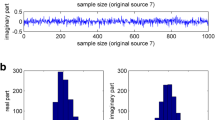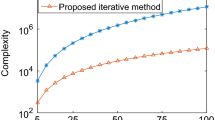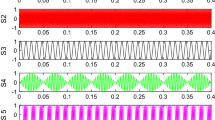Abstract
By utilizing a priori information available as reference, constrained independent component analysis (cICA) or independent component analysis with reference (ICA-R) achieves some advantages over other methods. However, ICA-R is very time-consuming; moreover, it is very difficult to determine its threshold parameter, once the value is improperly chosen the algorithm will fail to converge. In order to overcome these drawbacks, a very simple blind source extraction method, whose optimization function is simply the closeness measure between the desired output and its corresponding reference in ICA-R, is proposed in this paper. Experiments with synthesized data and real-world electrocardiograph data confirm its validity and superiority.







Similar content being viewed by others
Explore related subjects
Discover the latest articles, news and stories from top researchers in related subjects.Notes
P = (p1, p2, …,p m ) is called a canonical basis vector, if p i = 1 and p l = 0,∀l ≠ i [1].
Since s i ’ are mutually independent and we assume E{s 2 i } = 1, we have E{ss T} = I. \(\tilde{\bf{x}}\) is whitened, so we have \( E\{{\tilde{\bf{x}}\tilde{\bf{x}}}^{T} \} = \left({{\bf{VA}}} \right)E\{{\bf{ss}}^{T} \} \left({{\bf{VA}}} \right)^{T} = \left({{\bf{VA}}} \right)\left({{\bf{VA}}} \right)^{T} = {\bf{I}}. \) Hence, VA is orthogonal. Due to ||w|| = 1 and VA being a unitary matrix, we can get ||p|| = ||w T VA|| = ||w T|| = 1. This is why any p in Table 1 is near to a canonical basis vector.
References
Barros AK, Cichochi A (2001) Extraction of specific signals with temporal structure. Neural Comput 13:1995–2003
Cichochi A, Amari S (2004) Adaptive blind signal and image processing: learning algorithms and applications. Wiley, New York
De Moor D (1997) Daisy: database for the identification of systems. Available http://www.esat.kuleuven.ac.be/sista/daisy
Huang DSh, Mi JX (2007) A new constrained independent component analysis method. IEEE Trans Neural Netw 18:1532–1535
Hyvärinen A (1999) Fast and robust fixed-point algorithms for independent component analysis. IEEE Transn Neural Netw 10:626–634
Hyvärinen A, Oja E (2000) Independent component analysis: algorithms and applications. Neural Netw 13:411–430
Ille N, Berg R, Scherg M (2001) Spatially constrained independent analysis for artifact correction in EEG and MEG. Neuroimage 13:S159
Jafari MG, Chambers JA (2005) Fetal electrocardiogram extraction by sequential source separation in the wavelet domain. IEEE Trans Biomed Eng 52:390–400
James CJ, Gibson OJ (2003) Temporally constrained ICA: an application to artifact rejection in electromagnetic brain signal analysis. IEEE Trans Biomed Eng 50:1108–1116
Lin Q-H, Zheng Y-R, Yin F-L, Liang H, Calhoun VD (2007) A fast algorithm for one-unit ICA-R. Inform Sci 177:1265–1275
Lu W, Rajapakse JC (2005) Approach and applications of constrained ICA. IEEE Trans Neural Netw 16:203–212
Lu W, Rajapakse JC (2006) ICA with reference. Neurocomputing 69:2244–2257
Zhang ZL (2008) Morphologically constrained ICA for extracting weak temporally correlated signals. Neurocomputing 71:1669–1679
Acknowledgments
The authors would like to thank the anonymous reviewers for their valuable and constructive comments, which greatly improved the manuscript’s readability. This work was supported by NSFC under Grant No. 60736009.
Author information
Authors and Affiliations
Corresponding author
Rights and permissions
About this article
Cite this article
Li, C., Liao, G. A reference-based blind source extraction algorithm. Neural Comput & Applic 19, 299–303 (2010). https://doi.org/10.1007/s00521-009-0303-x
Received:
Accepted:
Published:
Issue Date:
DOI: https://doi.org/10.1007/s00521-009-0303-x




